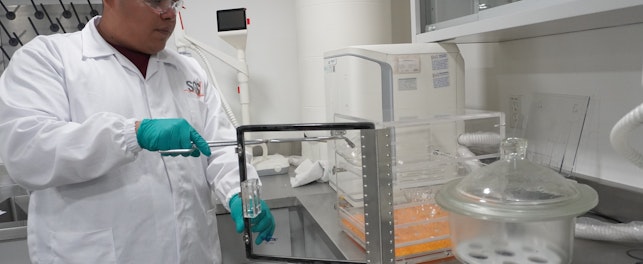Consumers want multiple things from their clothes – look nice, perform well and feel good. But above all, they want them to be safe. However, some recent studies from North America have found levels of harmful chemicals in clothing that exceed regulatory requirements.
PFAS in clothing
Per- and polyfluoroalkyl substances (PFAS) are a diverse group of synthetic chemicals with a wide range of uses. They are often used in treatments for fabrics and textiles because of their unparalleled water, oil, grease and dirt repellent properties. However, they are now known to be toxic, persistent and bioaccumulative in the environment, and are often now called ‘forever chemicals.’
PFAS have linked to several human health problems, including:
- Asthma
- Cancer (testicular, kidney, liver and pancreatic)
- Weakened immunity in children
- Low birth weight
- Endocrine (hormone) disruption
- Increased cholesterol levels
- Weight gain
In June 2021, one company supplying female period underwear received a class action after it was found some of their products contained PFAS at levels as high as 3,264 ppm, significantly above ‘trace levels.’1 In January 2022, a study published in Environmental Health News and conducted by an online eco-wellness site found that one in four pairs of leggings and yoga pants, from a sample of 32 products available on the market, tested positive for the PFAS indicator fluorine.2
Most recently, a University of Toronto study on September 2022 found that 65% of the clothing products they tested contained PFAS. Of particular concern was the fact that school uniforms made from 100% cotton or cotton and synthetic blends contained the highest amounts of PFAS. Other children’s clothing was also commonly found to contain fluorotelomer alcohols (FTOHs), a substance used in the production of PFAS.3
BPA in clothing
Bisphenol A (BPA) is another chemical causing concerns. It is known to relate to developmental issues, serious eye damage, respiratory irritation, skin allergies and reproductive harm. Some countries have already prohibited it from water bottles, cashier thermal paper and other consumer products.
There are a number of possible reasons why this harmful substance might be found in clothing and textiles because of its use as an:
- Antioxidant in intermediary steps during the production of polyester to improve natural properties, lifespan and thermostability
- Antistatic treatment in products like Spandex
- Polyurethane (PU) protective agent
- Adhesive and in coatings and trims
- From recycled materials, e.g., rPET from water bottles, etc.
BPA was not traditionally considered a high-risk chemical in textiles. However, after recent discoveries, its presence in some clothing products has begun to cause concern.
In California, USA, BPA has been given a maximum allowable dose level via skin exposure of three micrograms per day, under California Proposition 65 (Prop 65). In September 2021, the Californian Center for Environmental Health (CEH) found BPA was present at levels above regulatory requirements in socks made primarily of polyester with Spandex. The first settlement associated with this finding resulted in a reformulation limit of no more than 1 ppm.4
In October 2022, the CEH then found sports bras being sold by a number of companies that could expose wearers to up to 22 times BPA’s safe harbor limit. Similar results were also reported in women’s sports bras and athletic shirts.5
Regulatory action
Markets are more aware than ever before of the possible harmful effects of exposure to PFAS and BPA, which has led to an increase in legislative activities around these substances.
PFAS are regulated in the European Union (EU) under the POP (persistent organic pollutants) Recast Regulation and Regulation (EC) 1907/2006 on Registration, Evaluation, Authorization and Restriction of Chemicals (REACH). They are also regulated under Toxics in Packaging Clearinghouse (TPCH) and by state laws in the US and by several Asia Pacific countries. In addition, stakeholders should be aware new regulations are also being proposed in the US, EU and Japan to extend restrictions and prohibitions.
While much of the focus surrounding BPA regulations has been on items like children’s products, thermal paper and food contact materials, clothing and textiles are still regulated in Europe and areas of the US. In the EU they come under REACH and in the US under a variety of jurisdiction regulations in places such as Maine, Oregon, Vermont and Washington. Globally, other countries are also beginning to look at restrictions on BPA in a variety of consumer goods.
Prove compliance through testing
With concerns over the presence of harmful chemicals like PFAS and BPA growing globally, manufacturers of clothing and textiles need to ensure their products remain compliant with the relevant regulations in their target markets.
However, the regulatory landscape is uneven and new restrictions and prohibitions are being introduced and implemented all the time. Manufacturers are therefore advised to adopt a proactive approach to the testing of their softlines products in order to ensure continued compliance. They should work with a specialist testing, inspection and certification (TIC) company that has the global reach and high-level local knowledge necessary to synthesize the requirements enforced in different markets while also staying ahead of potential regulatory changes.
SGS Solution
With a global network of over forty state-of-the-art laboratories specializing in testing apparel, footwear and accessories, we are the first choice for manufacturers and buyers who are looking to ensure their softlines products comply with the increasing number of regulations covering harmful substances like PFAS and BPA.
We work with all stakeholders in global supply chains. Our experts use a four-stage process that provides accurate and trusted product assessments relating to substances such as PFAS and BPA:
- Evaluate – identify high risk products based on recent market concerns and regulations
- Define a testing approach – ensure compliance with client specifications and market requirements
- Testing – conduct testing against recognized methodologies
- Report – deliver data and a report with PASS/FAIL/WARNING conclusions
As markets around the world become increasingly competitive, adopting a proactive approach to hazardous substance testing will not only demonstrate regulatory compliance but also enable and improve market access and brand trust. In the end, it’s only trusted because it’s tested.
Learn more about SGS’s Softlines services.
Enjoyed this article?
Find more news and updates in our Consumer Compact newsletter >
For further information please contact:
Min Zhu, Ph.D.
US & Canada Softlines, Technical Director
Connectivity & Products, SGS
t: +1 (973) 461-1230
References
1 Thinx Toxic Underwear a ‘Safety Hazard to the Female Body,’ Claims Class Action Lawsuit - Top Class Actions
2 8 brands with PFAS indicators - EHN
3 Toxic chemicals found in children’s school uniforms | CTV News
4 U.S. California Prop 65 Settlement on Bisphenol-A (BPA) in Socks | SGS
5 High levels of BPA found in sports bras, watchdog warns | CNN Business
© SGS Société Générale de Surveillance SA. This publication or website is a property of SGS Société Générale de Surveillance SA. All contents including website designs, text, and graphics contained herein are owned by or licensed to SGS Société Générale de Surveillance SA. The information provided is for technical and general information purposes only and offers no legal advice. The information is no substitute for professional legal advice to ensure compliance with the applicable laws and regulations. All information is provided in good faith “as is”, and SGS Société Générale de Surveillance SA makes no representation or warranty of any kind, express or implied, and does not warrant that the information will be error-free or meet any particular criteria of performance or quality.



